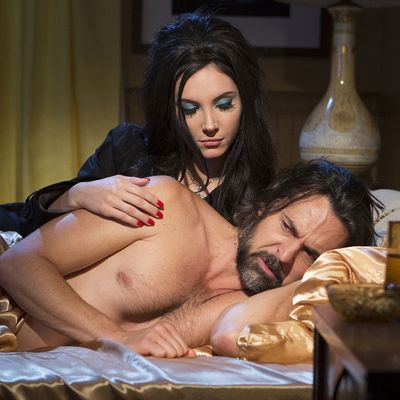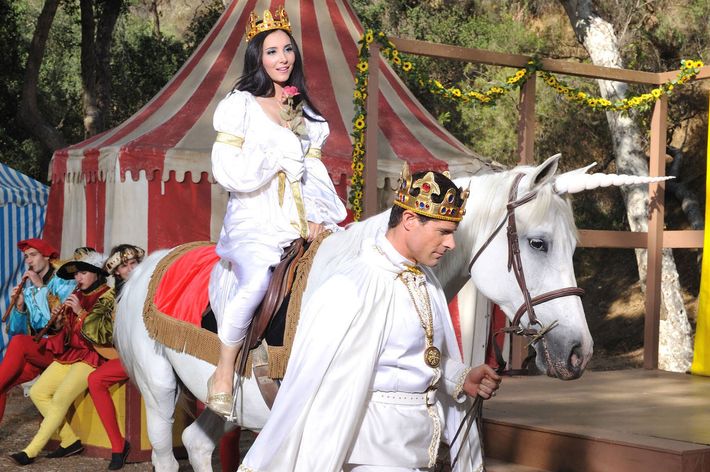
Anna Biller’s The Love Witch is not Hallmark material. Engrossing though the acclaimed 2016 independent sex-horror film may be, it doesn’t exactly sound like an ideal date movie: It’s the story of an abuse survivor who turns to witchcraft in an attempt to find true love, but who’s so good at her work and so numb to the needs of her lovers that she drives a series of men to insanity and death with the pure power of her sexual and romantic energy.
However, this overview of the film — which is now available for streaming or download via its distributor, Oscilloscope Pictures — barely scratches the surface. In all the ways that count, other than, y’know, the untimely deaths of the male characters, The Love Witch is this year’s Valentine’s Day movie to beat.
For starters, The Love Witch is film as a sensual experience. The sets, the costumes, the lighting, even the cast are as decadent and delicious to look at as a chocolate-covered strawberry is to taste. Shot and edited on film to create a lush throwback look that belies the arduous process involved, it’s a movie designed to make every color and texture pop. Eye shadow, blush, and lip gloss look like they’d smear if you touched the screen. The countless shots of food and drink will make your mouth water. The kaleidoscopic effects of hallucinogens and occult rituals alike are recreated to intoxicating effect.
And whether male or female, human skin has rarely looked so inviting to touch as it does here. The vintage quality of The Love Witch’s cinematography adds a certain distance to our view of the characters, a lack of immediacy that gives us an aesthete’s view of the characters’ sexual liaisons. Multiple prolonged sequences of men and women getting dressed and undressed enhance our appreciation of bodies and their presence in the world. Throw in the retro styling of Samantha Robinson as the titular witch Elaine, and Gian Keys as her love interest, and the movie is drawing from the power of decades of pinup-worthy hunks and heroines.
Importantly, The Love Witch is written and shot with a near-total disregard for what men are interested in seeing and hearing. Biller shoots the movie with an eye that’s as far from the male gaze as possible, focusing instead on how women (“beautiful” women specifically) experience the world on their own. Yes, there’s a negative aspect to this: “She exults about the power and freedom [female sexuality] gives her,” Biller told Birth.Movies.Death, “while we hear thoughts in her head about her resentment of men, blanked out expressions while she’s serving men sexually and with food, and flashbacks of her abuse and coercion by men.”
Still, there’s a deep-down satisfaction and thrill in seeing the world in general, and the world of romantic and sexual relationships specifically, processed entirely through the viewpoint of a woman who’s doing her level best to thrive in her own situation. Whatever your gender, the shock of recognition in seeing Elaine comfort her doomed lovers by condescendingly purring “poor baby,” like a self-aware synthesis of madonna and whore, should provide ample grist for your erotic mill. It’s an all-too-rare sex-horror movie in which the prime mover of both sex and horror is a woman, and as such, it’s hugely exciting to behold. For men it’s a novelty; for everyone, it’s a necessity.
On an even deeper level, The Love Witch is a rare movie about love that’s actually about love, as a concept. Romantic comedies, melodramatic tragedies, and even other horror romances like the recent Polish import The Lure just sort of take it for granted that the characters and the audience alike understand love: what it is, why it’s good, why we want it, why we’re sad not to have it. But over the course of this movie, Elaine and her male and female interlocutors alike engage in a robust debate about the nature of love itself. Is it spontaneous, or the result of conscious campaigning? Is love only real if you love a person for “who they are,” or is it better thought of as the result of a give and take, a transaction of desired states? Do men and women view love differently, and if so, what does that mean for their equality? Is sex intrinsic to love, or is it a means to the end, or does it exist independently of love entirely? Every potential answer to each of these questions gets a thorough workout over the course of the movie. Wherever you come down on any of them, you’re given plenty of food for thought.

Indeed, the sequence at the movie’s center is a Renaissance Faire reenactment of a wedding ritual — a scene in which actors pretend to be people pretending to be people in love, peeling the emotion apart layer by layer. Let’s Talk About Love, Céline Dion once proposed via album title; Let’s Think About Love could well be this movie’s subtitle. If you’ve ever spent a few hours dissecting a movie you’ve just seen with a date over diner food, this is a five-course meal.
But the most romantic thing about The Love Witch is the existence of the film itself. To call a work of art “a labor of love” is to imply a sort of jejune passion, an amateur’s enthusiasm, but nothing could be further from the case here. Taking the concept of the auteur to a whole new level, Anna Biller not only wrote, edited, scored, produced, and directed this movie — she also served as the production designer, the set decorator, the art director, and the costume designer. She personally built, knit, sewed, collected, or otherwise provided many of the film’s key props, from the witches’ altar to the characters’ jewelry to a rug that took her months to make. If the lengthy and thoughtful essays and interviews on her blog are any indication, she also served as the movie’s on-set philosopher. Short of starring in the movie herself, there’s no way The Love Witch could be more Anna Biller’s vision.
The result is unmistakably familiar. To watch The Love Witch is to enter the headspace and heartspace of another human being as surely as falling in love.
This becomes crystal clear barely five minutes into the film. After an opening driving sequence that’s a loving homage to similar scenes in Hitchock’s Psycho and The Birds, we enter the Billerverse in earnest — a world where every detail is deliberate and delightful. Tucking her cherry-red cigarette case into her cherry-red purse, Elaine emerges from her cherry-red car in her cherry-red dress, then takes her cherry-red suitcase out of the cherry-red trunk to enter an apartment full of occult artwork so colorful it’d make a Crayola 64-pack blush. Next, we’re off to a sumptuously appointed tea room in which every one of the all-female clientele is clad in cotton-candy pink; the matching floral-patterned tea set, hand selected by Biller herself, looks like something made of marzipan in the sugar-spun home of a fairy-tale cannibal witch.
By the time I hit this point in the movie, I was laughing out loud in sheer joyful admiration. Whether working in true independent form like Biller or blessed with the carte blanche freedom afforded to established and acclaimed names like Scorsese, Anderson, Tarantino, or Coen, few filmmakers have anything close to this level of confidence in their own taste and vision. Pulling this off for a single scene would be reason to celebrate. Constructing an entire film from a single intelligent, idiosyncratic worldview is close to a miracle. And from its first scene to its last, from the font choice in its opening titles to the music over the closing credits, that kind of miracle is exactly what The Love Witch delivers. Watch it with some witch you love.

